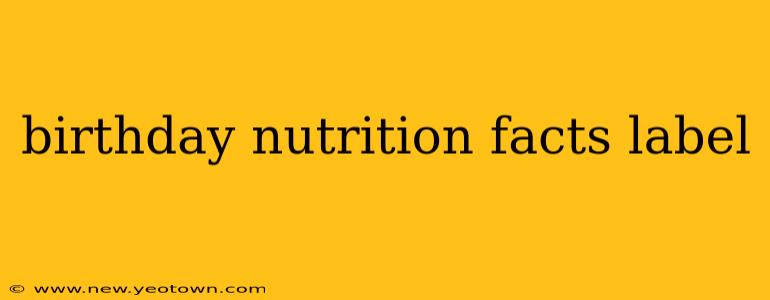Let's be honest, who doesn't love a slice (or two!) of birthday cake? That fluffy, sweet delight is a centerpiece of celebrations worldwide. But have you ever really looked at the nutrition facts label? It's a tiny window into the caloric and nutritional composition of your celebratory treat. This exploration will delve into the often-overlooked details on that small label, answering many common questions people have about birthday cake nutrition.
What are the typical nutritional components of a slice of birthday cake?
This is a tough question because birthday cakes vary wildly! A simple, homemade sponge cake will have a drastically different nutritional profile than a rich, decadent chocolate fudge cake laden with frosting and sprinkles. However, we can paint a general picture. Typically, a standard slice of birthday cake will be high in:
- Sugar: This comes from the sugar in the cake batter itself, plus any added sugars in the frosting. This is usually the biggest contributor to the overall calorie count.
- Fat: Butter, oil, and frosting are major sources of fat. The type of fat (saturated, unsaturated) can vary depending on the recipe.
- Carbohydrates: Flour is the primary source of carbohydrates, providing the cake's structure.
- Calories: A single slice can easily contain 300-500 calories or more, depending on the size and ingredients.
It's important to remember these are just estimates. Always check the specific nutrition label provided by the bakery or manufacturer.
How many calories are in a typical slice of birthday cake?
As mentioned above, the calorie count varies tremendously. A small, simple slice might contain around 300 calories, while a larger, more elaborate slice could easily exceed 500. Factors like frosting type, cake size, and the addition of nuts or candies significantly impact the total calorie count.
What are the ingredients that contribute the most calories in birthday cake?
The main calorie culprits are usually:
- Sugar: Refined sugar adds a significant amount of empty calories.
- Fat: Butter and frosting are dense sources of calories. The type of fat influences the nutritional impact – saturated fats from butter are less desirable than unsaturated fats from some oils.
- Flour: While not as calorically dense as fat and sugar, the amount of flour used in a cake significantly adds to the overall carb and calorie count.
Does the frosting significantly impact the nutrition information?
Absolutely! Frosting is often the most calorically dense part of the cake. A thick layer of rich buttercream or cream cheese frosting can add hundreds of calories to a single slice. The type of frosting also impacts the fat content – buttercream frosting tends to be higher in saturated fat compared to some lighter frostings.
How can I make a healthier birthday cake?
You can absolutely enjoy a birthday cake while being mindful of your nutritional intake. Consider these healthier swaps:
- Use less sugar: Reduce the amount of sugar in the recipe or use healthier alternatives like honey or maple syrup (in moderation).
- Opt for healthier fats: Replace butter with applesauce or Greek yogurt to reduce fat and calories.
- Choose whole wheat flour: Using whole wheat flour instead of all-purpose flour adds fiber and nutrients.
- Limit frosting: Use a thinner layer of frosting or opt for a healthier frosting alternative, such as a fruit glaze.
- Portion control: Enjoy a smaller slice to manage your calorie intake.
By making smart ingredient choices and practicing portion control, you can enjoy a delicious and healthier birthday cake without sacrificing taste.
Remember, moderation is key. Enjoy your celebratory slice of cake, but be aware of its nutritional content and make informed choices based on your individual dietary needs and preferences. Happy birthday!

